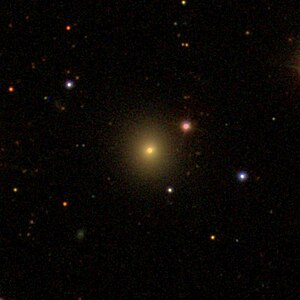IC 1696
| Galaxie IC 1696 | |
|---|---|
 | |
| SDSS-Aufnahme von IC 1696 | |
| AladinLite | |
| Sternbild | Walfisch |
| Position Äquinoktium: J2000.0, Epoche: J2000.0 | |
| Rektaszension | 01h 24m 52,3s[1] |
| Deklination | -01° 37′ 01″[1] |
| Erscheinungsbild | |
| Morphologischer Typ | E+[1][2] |
| Helligkeit (visuell) | 13,6 mag[2] |
| Helligkeit (B-Band) | 14,6 mag[2] |
| Winkelausdehnung | 0.90 × 0.8[2] |
| Positionswinkel | 10°[2] |
| Flächenhelligkeit | 13.3 mag/arcmin²[2] |
| Physikalische Daten | |
| Zugehörigkeit | Abell 194 WBL 45[1] |
| Rotverschiebung | 0.019547 ± 0.000037[1] |
| Radialgeschwindigkeit | 5860 ± 11 km/s[1] |
| Hubbledistanz vrad / H0 | (264 ± 19) · 106 Lj (81,0 ± 5,7) Mpc [1] |
| Geschichte | |
| Entdeckung | Herbert A. Howe |
| Entdeckungsdatum | 19. Januar 1900 |
| Katalogbezeichnungen | |
| IC 1696 • UGC 973 • PGC 5231 • CGCG 385-113 • MCG +00-04-122 • 2MASX J01245237-0137014 • GALEXASC J012452.36-013700.0 • LDCE 89 NED007 | |
IC 1696 ist eine Elliptische Galaxie vom Hubble-Typ E1 im Sternbild Cetus südlich des Himmelsäquators. Sie ist schätzungsweise 264 Millionen Lichtjahre von der Milchstraße entfernt und hat einen Durchmesser von etwa 70.000 Lichtjahren.
Im selben Himmelsareal befinden sich u. a. die Galaxien NGC 519, NGC 530, NGC 538, IC 1693.
Das Objekt wurde am 19. Januar 1900 von Herbert Alonzo Howe entdeckt.[3]
Weblinks
Einzelnachweise
Auf dieser Seite verwendete Medien
Autor/Urheber: Sloan Digital Sky Survey, Lizenz: CC BY 4.0
The sky image is obtained by Sloan Digital Sky Survey, DR14 with SciServer.
Angle of view: 4' × 4' (0.3" per pixel), north is up.
Details on the image processing pipeline: https://www.sdss.org/dr14/imaging/jpg-images-on-skyserver/



